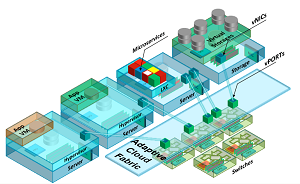News
Pluribus Evolves SDN Strategy by Killing the Controller
"SDN controllers introduced undesired complexity and limit interoperability."
First-generation software-defined networking (SDN) efforts are too complex, so Pluribus Networks today announced a new offering that aims to simplify the new-age approach, in part by eliminating the controller.
The virtualized architecture of the company's new Adaptive Cloud Fabric (ACF) also goes beyond just networking, seeking to help organizations transition to a full-blown software-defined-datacenter (SDDC). According to Pluribus, the ACF simplifies the journey from hardware-bound, static environments to software-driven, dynamic systems that provide programmability, automation, network intelligence, visibility and more -- running on open hardware and virtualized switches.
The company characterizes its new approach as evolving and simplifying earlier SDN and SDDC initiatives, where SDN controllers are key components. These controllers provide network intelligence, managing southbound traffic flows going from higher network layers to lower layers where switches and routers are located, along with northbound traffic from those lower layers to the higher levels where business logic resides.
In its mission to simplify SDN setups, ACF does away with the first-generation controller approach.
"Widespread SDN deployments have been inhibited by the complexity associated with controllers and proprietary protocols that require significant changes to the network architecture and operation," Pluribus said in a news release today. "SDN controllers introduced undesired complexity and limit interoperability, typically requiring replacement of the entire datacenter network to implement a software-defined deployment."
Pluribus claimed the ACF reduces that complexity and provides a less disruptive approach that doesn't involve controllers. "The Adaptive Cloud Fabric operates without a controller, and delivers a more dynamic and elastic network that adapts to change and a wide-range of deployment scenarios to streamline operations, improve efficiency and lower costs," the company said.
 [Click on image for larger view.] The ACF Abstracts Physical Ports to Virtual Ports (vPorts) (source: Pluribus Networks).
[Click on image for larger view.] The ACF Abstracts Physical Ports to Virtual Ports (vPorts) (source: Pluribus Networks).
Pluribus CTO Sunay Tripathi explained more about the controller-less approach in a blog post today.
"The previous generation of SDN architectures have been built on the Centralized Control Plane model, which inhibits architectures with slow reconvergence, single-points-of failures and is really only suitable for small deployments, which didn't require interoperability," Tripathi said.
"Some of the earlier SDN products were based on open switches, while older vendors took a proprietary ASIC-based approach with proprietary protocols that limited the deployments. But the one thing they all had in common, is that they required a controller, which limited SDN success."
The ACF runs on the company's Netvisor virtualized Network Operating System (NOS), which virtualizes hardware switches in much the same way that VMware virtualizes bare-metal servers, Pluribus said. That approach was lauded by Nick Lippis, an exec at the Open Networking User Group, which is holding a conference where the Pluribus announcement was made.
"As the industry transitions to a cloud-based software-defined world, the Pluribus Networks Adaptive Cloud Fabric has many of the attributes needed as infrastructure DevOps professionals build fabrics custom tailored to their corporation's digital transformation strategy requirements," Lippis was quoted as saying. "Their fabric architecture and the ability to virtualize the switch is a unique capability that allows users to achieve new capabilities from their network such as integrating new services, and building granular segmentation across a network fabric. In particular its automation and programmability plus integrated end-to-end visibility features will be warmly received."
Tripathi provided the following bullet-point list of ACF highlights:
- Runs on open switches with off-the-shelf chips like Broadcom Trident/Trident2/Tomahawk, Intel and other newer chips that are coming online.
- Fully distributed, peer-to-peer control plane with high availability and sub-second convergence for scale and resiliency.
- Abstraction of the underlying switch/port by creating a fabric vPORT that is the virtual endpoint of for server virtual machines (VM), containers, SR-IOV-enabled VMs, bare metal, Internet of Things (IoT) devices and so on.
- Integrated application-level analytics without taps or mirrors that show every TCP connection including time started/ended, IP addresses and TCP ports of end-points, average latency, bytes in either direction and more. The data is available in both real time and historical and is stored in memory.
- Fully multi-tenant in the form of VNETs which allow each tenant to work with its own Openstack or VMware environment, create server-to-switch tunnels, configure its fabric-wide ports, VLANs and more.
- Fully automated, programmable and interoperable in multi-vendor environments.
The ACF -- which can reportedly be used to target entire datacenters transformations or be more finely targeted to individual racks, pods, server farms or hyper-converged architectures -- is available now, along with Netvisor version 2.5.3 software and Insight Analytics.
About the Author
David Ramel is an editor and writer at Converge 360.